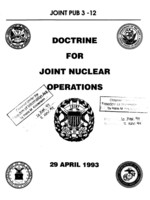Doctrine for Joint Nuclear Operations, April
1993
 The first
Doctrine for Joint Nuclear Operations (Joint Pub 3-12) was published on April 29, 1993. The context was the
ending of the Cold War and the reorganization of U.S. military planning
for joint operations. The first
Doctrine for Joint Nuclear Operations (Joint Pub 3-12) was published on April 29, 1993. The context was the
ending of the Cold War and the reorganization of U.S. military planning
for joint operations.
The doctrine adopted Weapons of Mass Destruction
(WMD) as the core terminology in defining the role of nuclear
deterrence, but without discussing the implications of broadening the
scope beyond nuclear to also deter other forms of WMD such as chemical
and biological weapons. As such Joint Pub 3-12 "mirrored" Cold War
deterrence against the Soviet Union onto the new security environment in
a more regional context.
Joint Pub 3-12 coincided with the emergence of other important documents
and efforts in the early 1990s which together broadened the scope of
U.S. nuclear deterrence to cope with "rogue" states in response to
increasing concerns over WMD proliferation (for background on this
evolution, see: Hans M. Kristensen, "Nuclear
Futures: Proliferation of Weapons of Mass Destruction and U.S. Nuclear
Strategy," British American Security Information Council
(BASIC), Washington, DC, March 1998).
Much of this effort occurred at
STRATCOM, which was stood up in June 1992 to provide a single voice for
nuclear policy. "Mission-creep" was inevitable because STRATCOM’s
efforts to formulate a credible regional nuclear deterrence against
"rogue" states armed with WMD spurred new nuclear strike
options and requirements for new capabilities such as low-yield nuclear weapons.
Indeed, the April 1993 Joint Pub 3-12 advocated
low-yield nuclear weapons as a means of making a decision to use nuclear weapons
easier:
"WMD used on US forces would cause a significant tactical or operational
loss; greatly change the character of the war, putting the outcome in
doubt and threatening escalation; leave the United States with a
difficult choice: to retaliate or not to retaliate. A selective
capability of being able to use lower-yield nuclear weapons in
retaliation, without destabilizing the conflict, is a useful alternative
for the US National Command Authorities (NCA)."
In many ways Joint Pubs 3-12 simply caught up with the
realities of nuclear planning that was well underway at the time. Even
before JP 3-12 was approved, STRATCOM planners began widespread
modernization of weapon systems and nuclear planning capabilities to be
able to target rogue states on a global scale. As a result, the "new"
doctrine JP 3-12 was based on existing key nuclear planning documents that
directed detailed nuclear planning against rogue states:
NUWEP (Guidance for the Employment of Nuclear Weapons) issued by
Defense Secretary Dick Cheney in November 1992, the
Joint Strategic
Capabilities Plan - Annex C (Nuclear) FY 1993-1995 from 1992, the
National Military Strategy Document - Annex B (Nuclear), and
SIOP-93
from April 1993.
The 1993 doctrine was replaced with
an updated Doctrine for Joint Nuclear Operations in December 1995.
|

